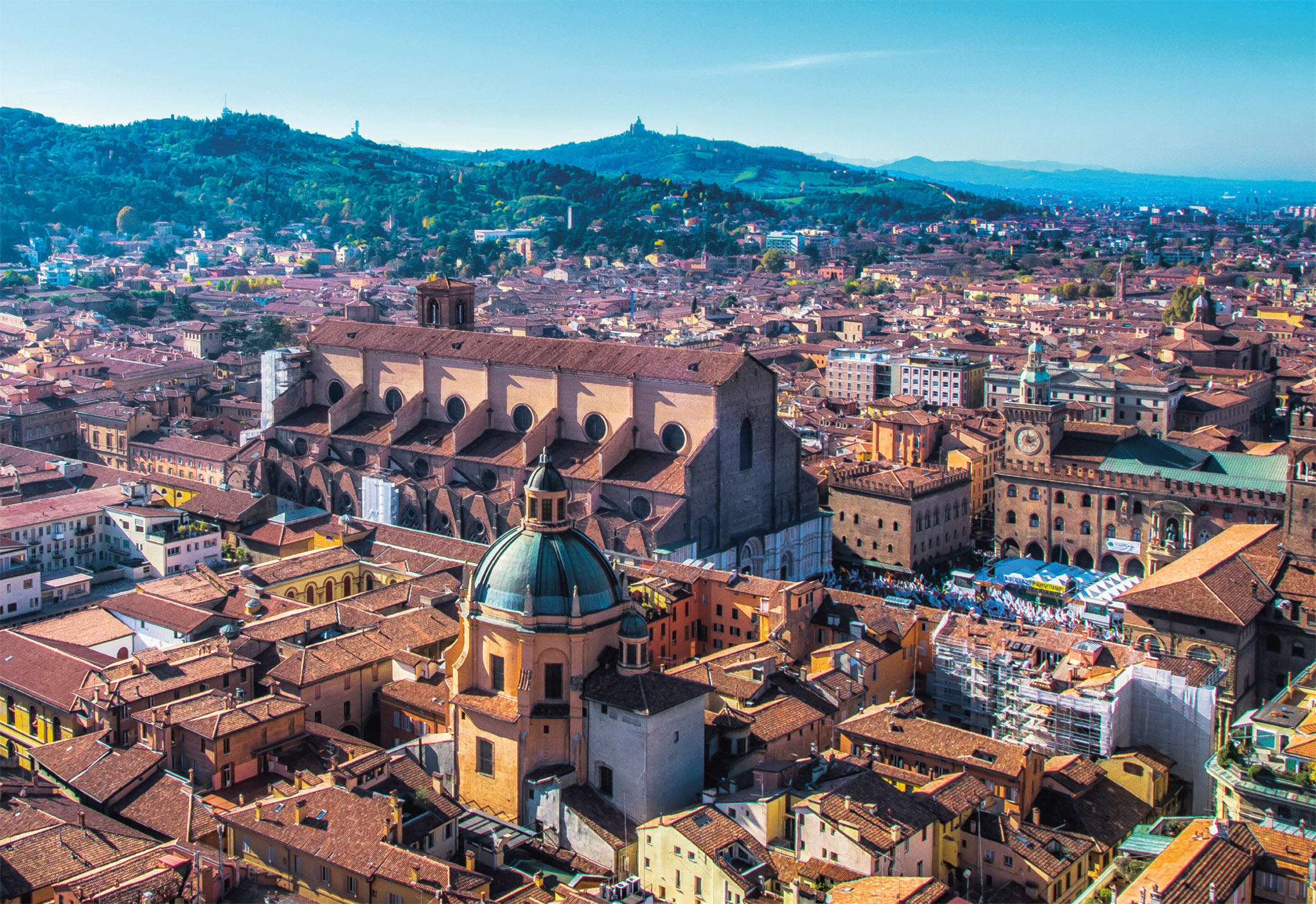
t View of Bologna’s rooftops from the top of Torre degli Asinelli
Widely recognized as Italy’s gastronomic capital, Bologna is home to an almost overwhelming number of eateries and food markets. The city’s historic core is a handsome ensemble of brick buildings and charming porticoed streets. Medieval palaces are clustered around the central Piazza Maggiore, which is dominated by the Basilica di San Petronio. The University of Bologna is the oldest in Europe and the venerable Archiginnasio was its first official building. The city’s main landmark is its pair of medieval towers – the 97-m- (318-ft-) high Asinelli and the leaning Garisenda tower.

t View of Bologna’s rooftops from the top of Torre degli Asinelli
Experience Emilia-Romagna
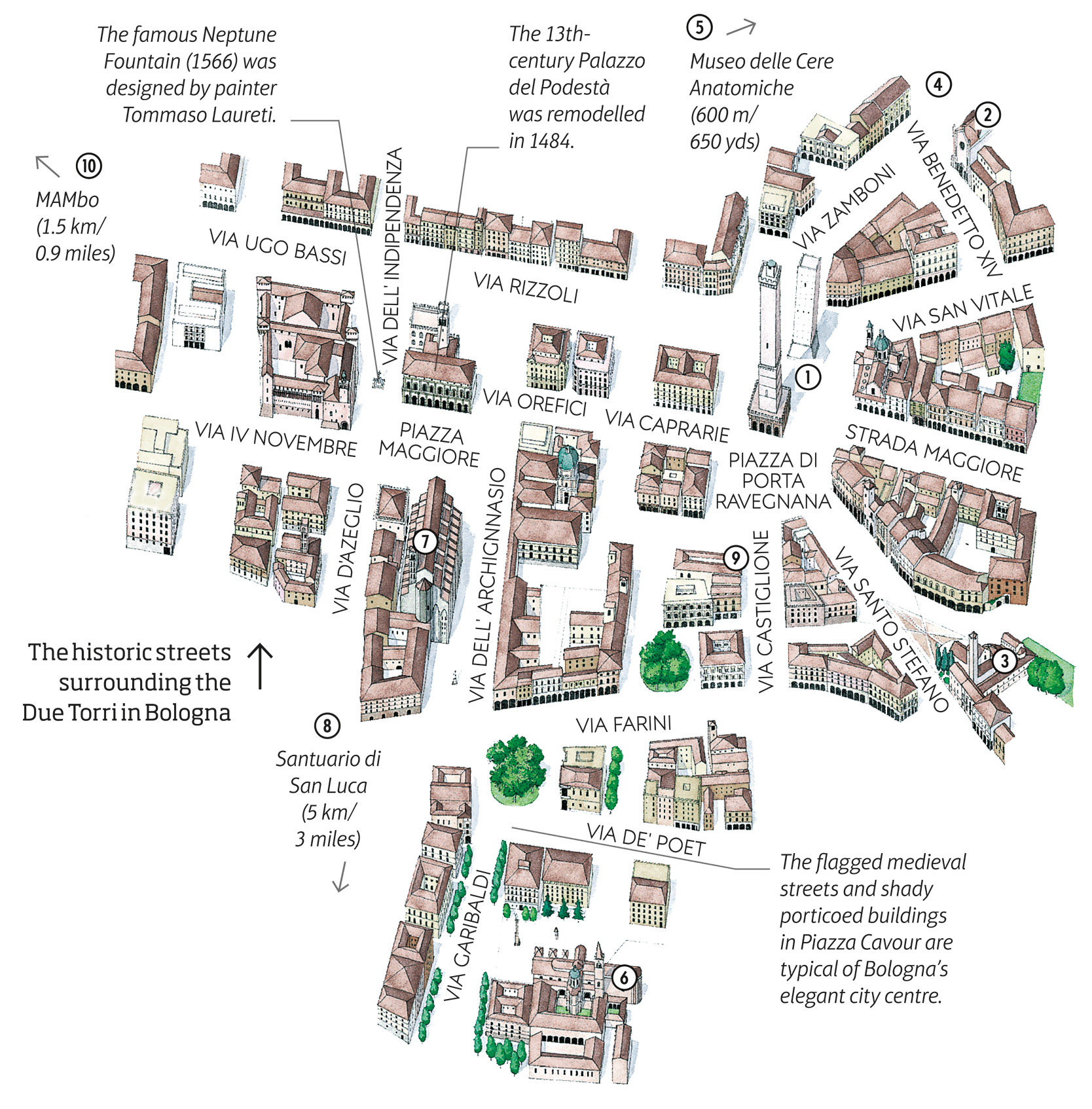
t The historic streets surrounding the Due Torri in Bologna
Only 20 of the original 100 towers that shaped Bologna's skyline in medieval times are still standing today and this eye-catching pair is in prime position in the centre of town. At 97 m (319 ft), Torre degli Asinelli is Italy’s fourth-tallest tower. The reward for climbing the 498 steps to the top is a fine view that stretches over the rooftops and hills. Torre della Garisenda, which was mentioned by Dante in his Inferno, was reduced in height from 60 m (197 ft) to 48 m (157 ft) in the mid-14th century, when it was feared it would collapse due to its lean from the vertical of 3 m (10 ft). Torre degli Asinelli also has a lean of around 2 m (7 ft).
" # 9:30am–5pm daily ∑ duetorribologna.com
This Romanesque-Gothic church, begun in 1267 but altered substantially since, is visited mainly for the Cappella Bentivoglio, a superb family chapel founded by Annibale Bentivoglio in 1445 and consecrated in 1486. Pride of place naturally goes to a portrait with subtle characterization of the patrons by Lorenzo Costa (1460–1535), who was also responsible for the frescoes of the Apocalypse, the Madonna Enthroned and the Triumph of Death. The chapel’s altarpiece, depicting the Virgin and Saints with Two Angel Musicians (1488), is the work of painter Francesco Francia. The Bentivoglio family is further glorified in the tomb of Anton Galeazzo Bentivoglio (1435) opposite the chapel. It was among the last works of the noted Sienese sculptor Jacopo della Quercia. The Oratory of Santa Cecilia features frescoes on the lives of Santa Cecilia and San Valeriano by Costa and Francesco Francia (1504–6).

Insider Tip
Take a trip to the hilltop village of Dozza, 25 km (15 miles) from Bologna. The medieval buildings here are decorated with bright murals, thanks to a biennial art festival.
Bologna has 38 km (23 miles) of covered walkways – more than any other city in the world.
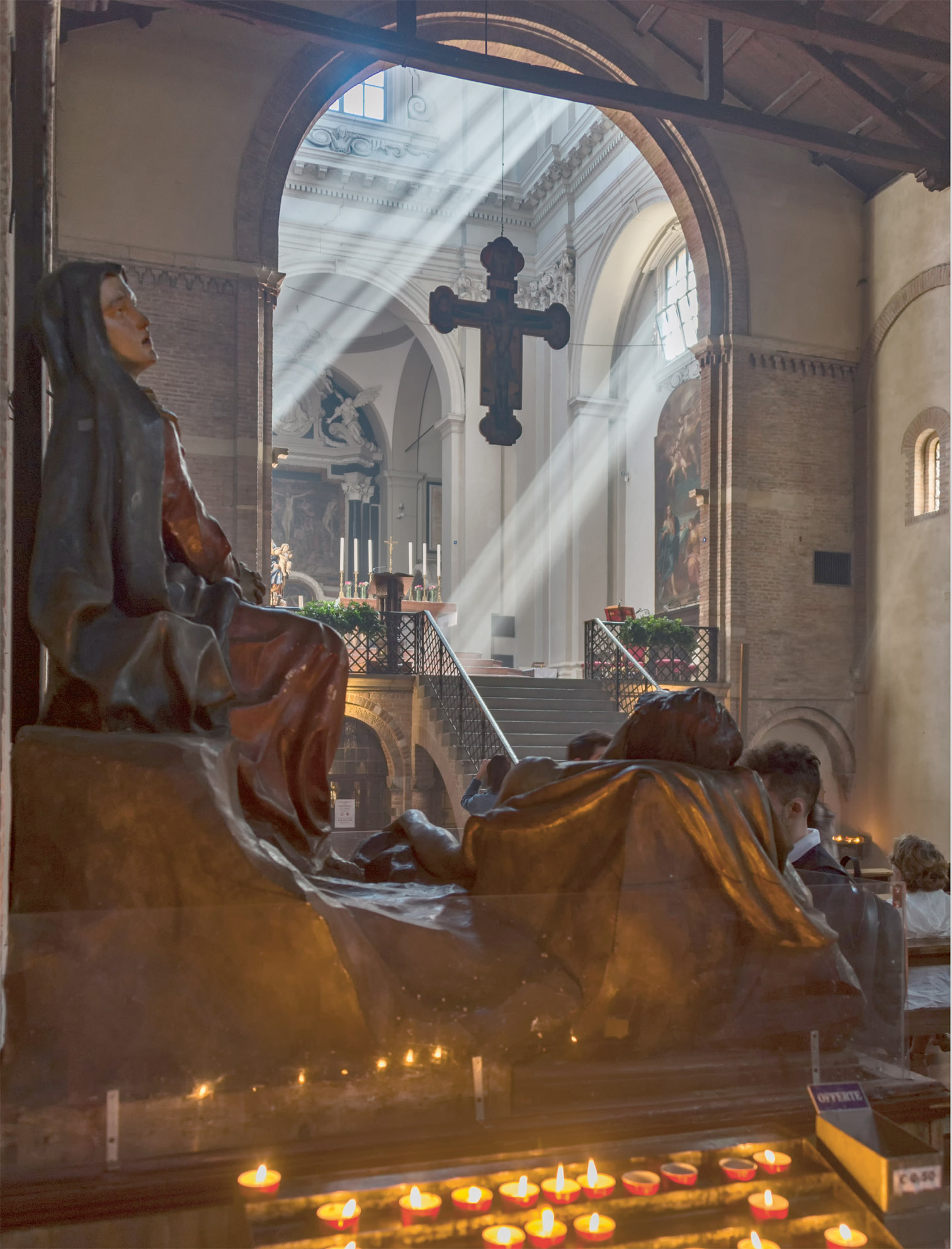
t Light streaming into the Church of the Crucifix, Basilica di Santo Stefano
Standing on central Bologna’s prettiest piazza, this is a complex of ecclesiastical buildings also known as the Sette Chiese, or the Seven Churches. It is a curious collection of four medieval churches (originally seven) jumbled together under one roof. The 11th-century church of the Crocifisso provides little more than a corridor leading to the polygonal San Sepolcro, the most appealing of the quartet. Also dating from the 11th century, its centrepiece is the tomb of St Petronius, a marvellously overstated affair that is modelled on the Holy Sepulchre of Jerusalem.
Parts of the church – those dedicated to saints Vitale and Agricola – date back to ancient times. To the rear of the complex is a courtyard with the Fontana di Pilata (a fountain incorporating an 8th-century marble basin), the Chiesa della Trinità, a 12th-century cloister with a Romanesque double-loggia, and a small museum featuring minor paintings and religious artifacts.
Bologna’s principal art gallery, and one of the region’s most important collections, stands on the edge of the city’s university district, a bustling area of bars, bookshops and cheap restaurants. The gallery is mainly dedicated to work by Bolognese painters, notably Vitale da Bologna, Guido Reni, Guercino and the Carracci family. Members of the Ferrarese school are also represented, in particular Francesco del Cossa and Ercole de’ Roberti. The two highlights are Madonna in Glory (c.1491) and Ecstasy of St Cecilia (c.1515) by Perugino and Raphael respectively, both artists who worked in Bologna.
The Museum of Anatomical Waxworks is one of the more interesting and memorable of Bologna’s smaller museums, featuring occasionally gruesome, visceral waxworks and numerous models of organs, limbs and flayed bodies. Sculpted rather than made from casts, the exhibits have an artistic as well as scientific appeal. The models were used as medical teaching aids until the 19th century. Exhibits from the 18th century are in Palazzo Poggi, which also contains the Geografia e Nautica collection.
Experience Emilia-Romagna
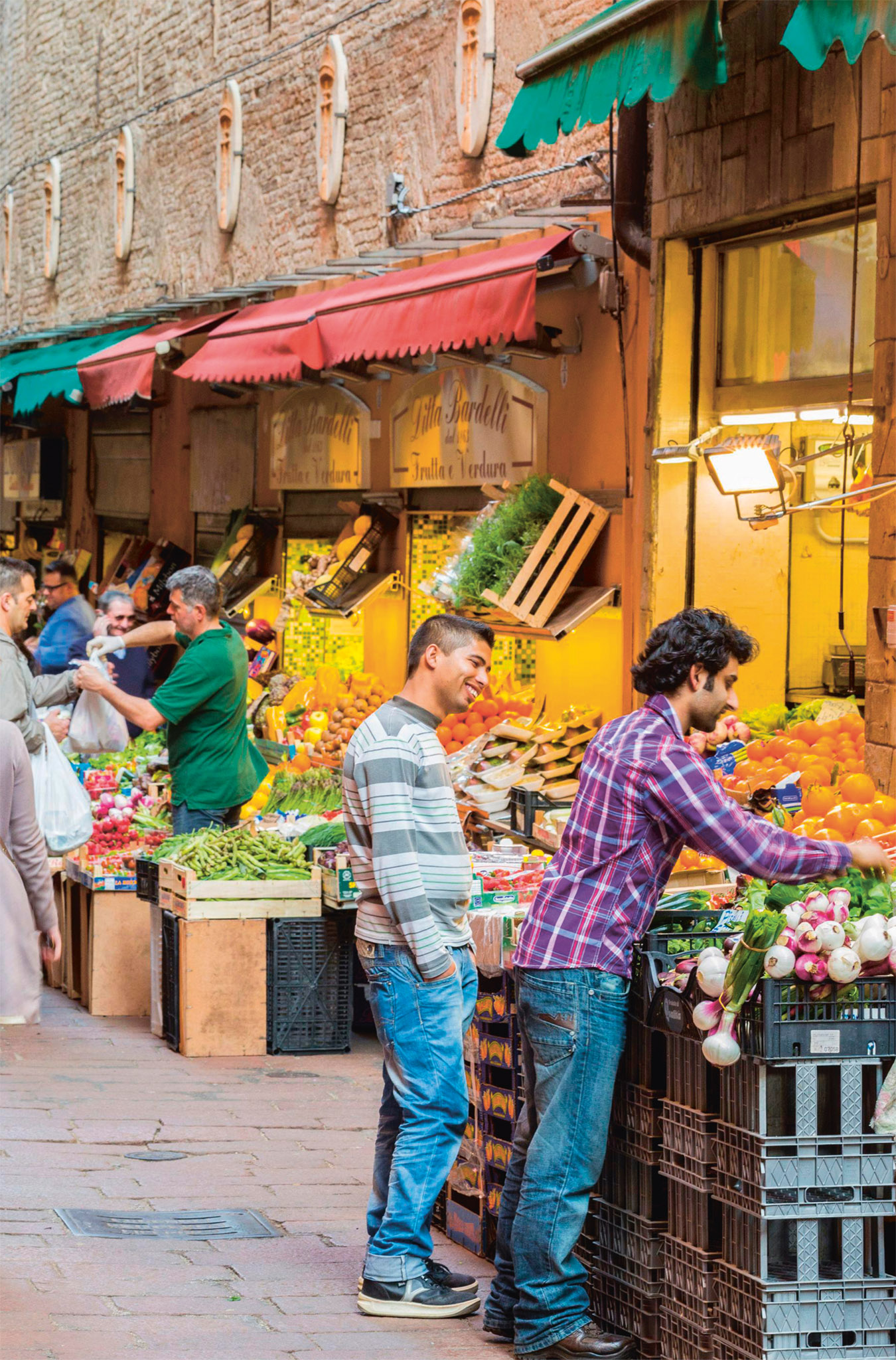
Just off Piazza Maggiore, Mercato di Mezzo is great for a snack while Mercato delle Erbe has good restaurants. The weekly Mercato Ritrovato (Via Azzo Gardino) includes high-quality Slow Food produce. FICO (Via Paolo Canali) is a veritable agri-food theme park with a wide range of eateries, factories and activities.
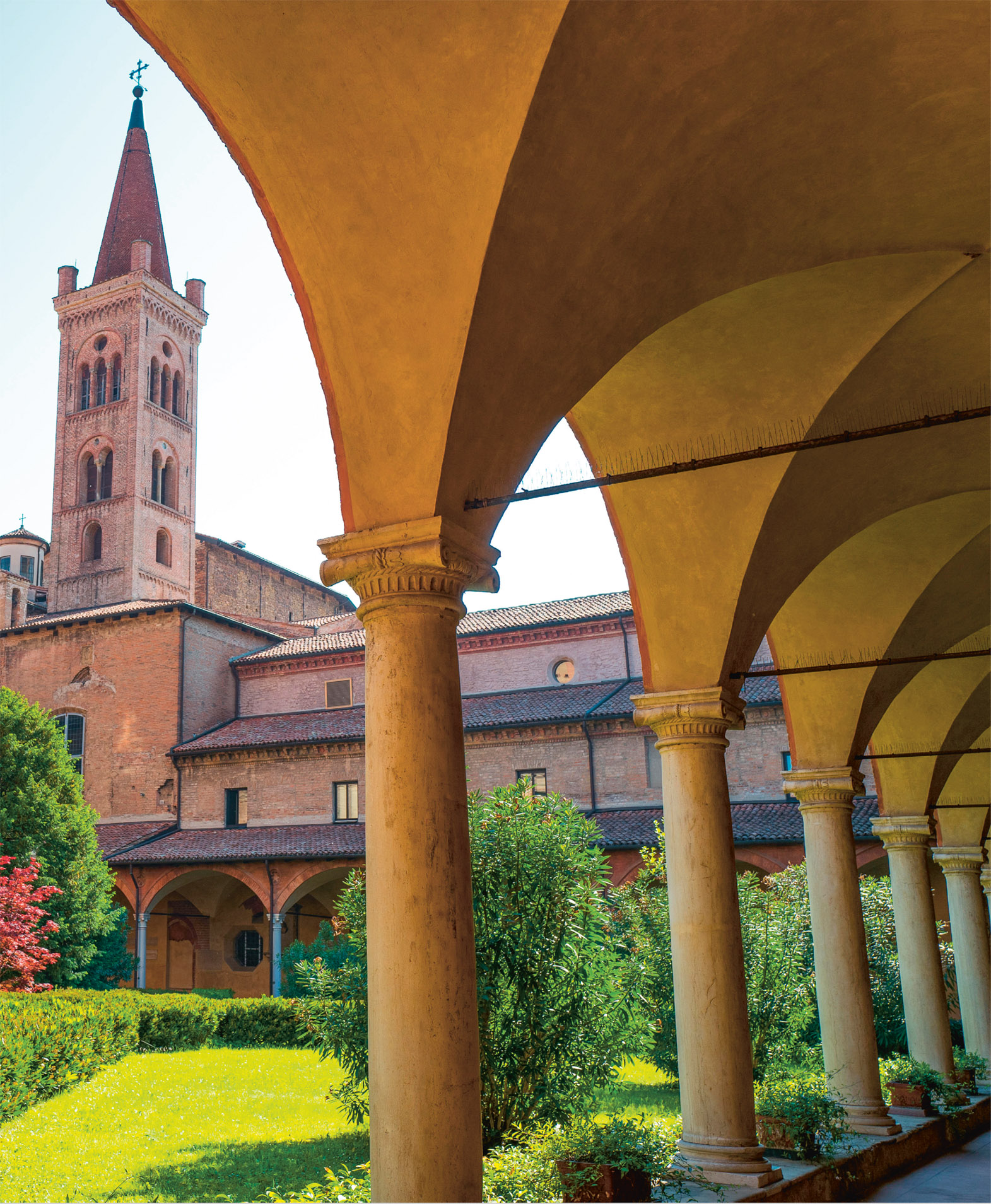
t The arcaded cloisters of San Domenico
Bologna’s San Domenico can lay claim to being the most important of Italy’s many Dominican churches. Begun in 1221, after St Dominic’s death, it was built to house the body of the saint, who died here and lies buried in a tomb known as the Arca di San Domenico, a magnificent composite work. The tomb’s statues were executed by Pisan sculptor Nicola Pisano; the reliefs of scenes from the Life of St Dominic were the work of Pisano and his assistants; the canopy (1473) is attributed to Nicola di Bari; while the figures of the angels and saints Proculus and Petronius are early works by Michelangelo. The reliquary (1383) behind the simple marble sarcophagus contains St Dominic’s head.
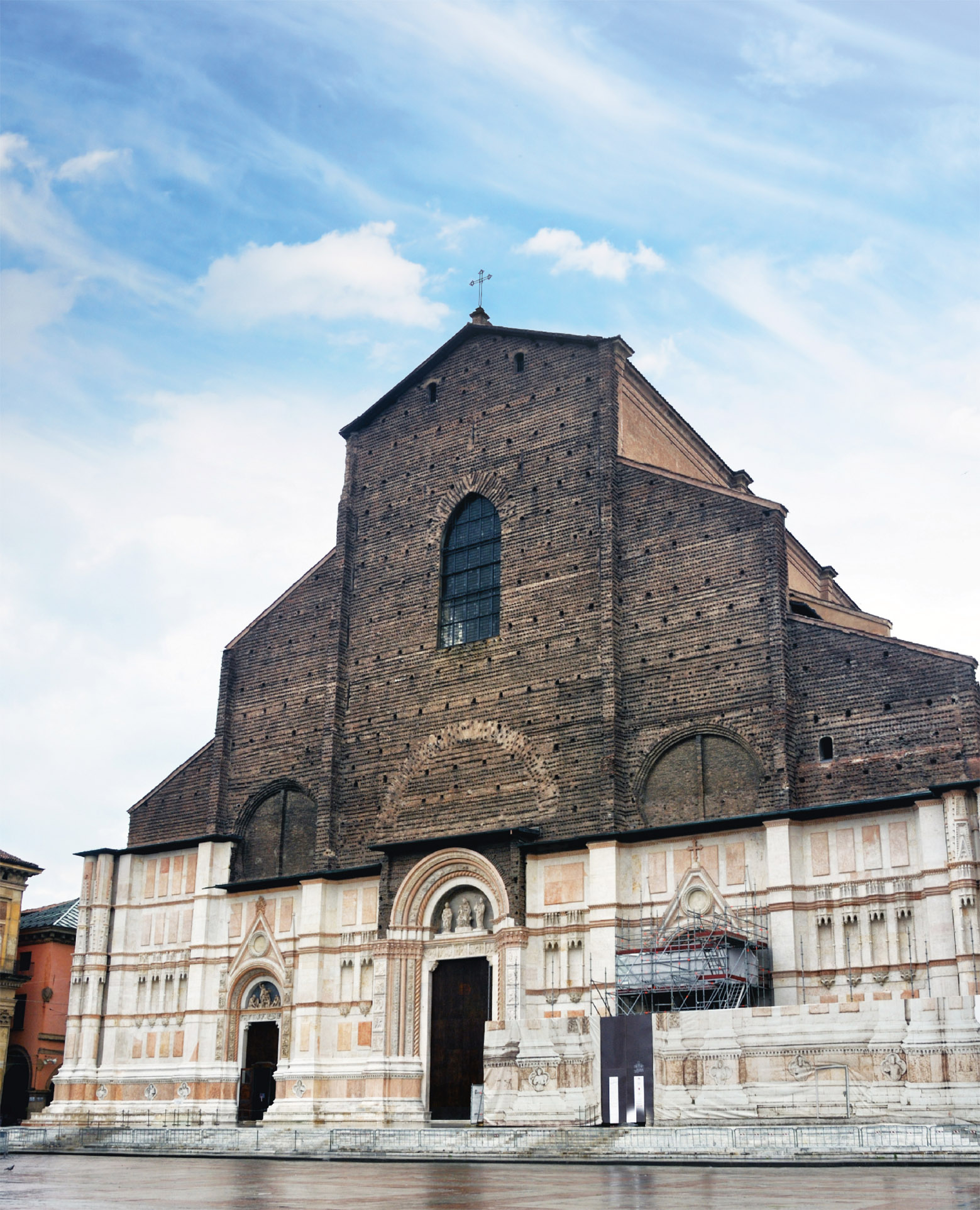
t The monumental façade of San Petronio
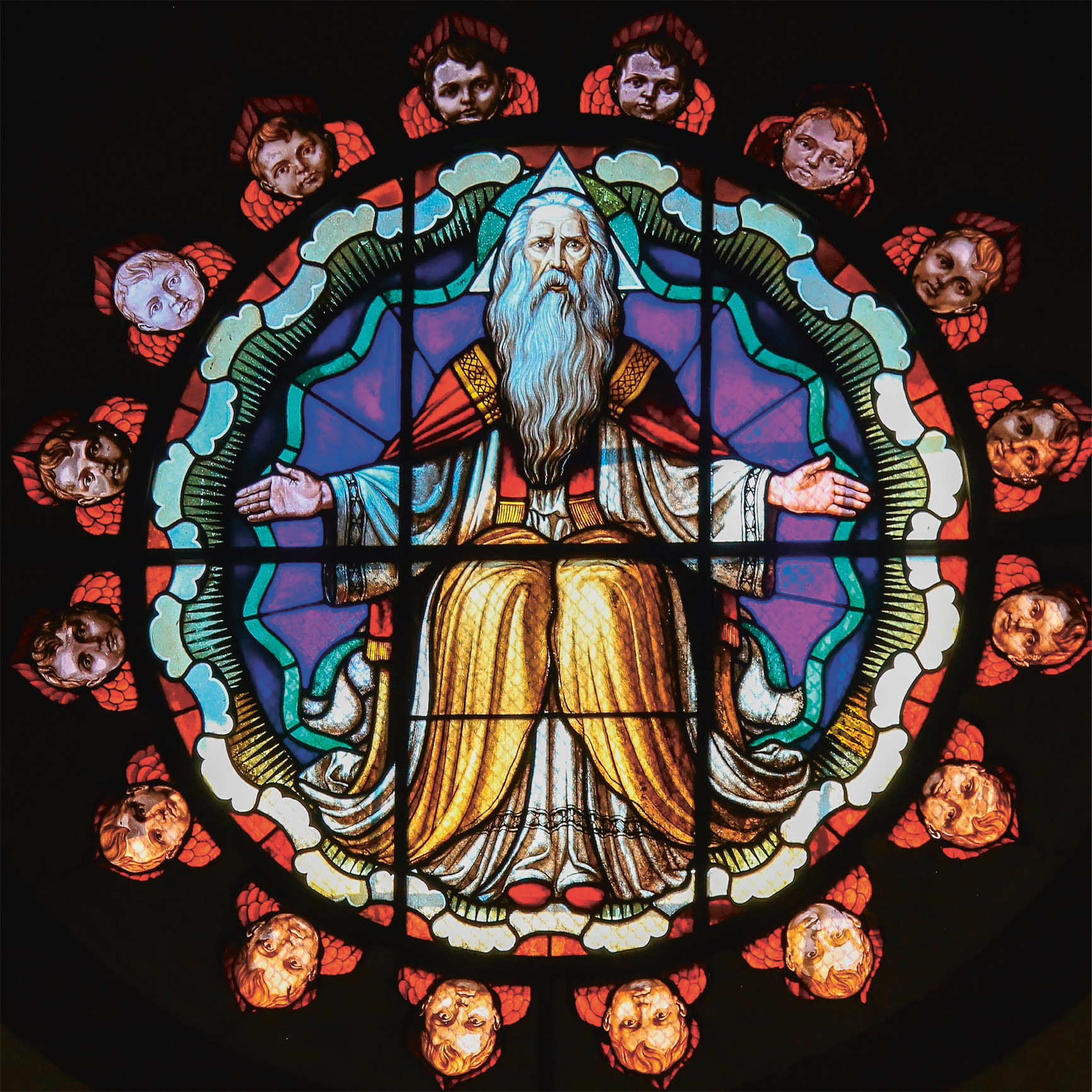
t One of its stained-glass windows
Dedicated to the city’s 5th-century bishop, this church ranks among the greatest of Italy’s brick-built medieval buildings. Founded in 1390, it was originally intended to be larger than St Peter’s in Rome, but its size was scaled down when the church authorities diverted funds to the nearby Palazzo Archiginnasio. The resulting financial shortfall left the church decidedly lopsided, with a row of columns on its eastern flank that were intended to support an additional internal aisle. The project’s financial recklessness, nonetheless, was said to have been instrumental in turning Martin Luther against Catholicism.
The airy Gothic interior features graceful pillars supporting the roof and a 67-m- (219-ft-) long meridian line on the floor which was traced in 1655 by the astronomer Gian Domenico Cassini. Twenty-two chapels, shielded by screens, open off the nave. In 1547 the Council of Trent was temporarily moved here due to the plague.
The longest uninterrupted section of the city’s porticoes leads the 4 km (2.5 miles) from the Porta Saragozza city gate to this hilltop church, a familiar beacon to travellers.
The current church, built between 1723 and 1757, presents an elegant exterior, while the interior contains a Byzantine Madonna and Child, which is carried in procession to the city’s San Pietro cathedral for a week each May. There are marvellous views out over the surrounding hills from the terraces.
The medieval Palazzo Pepoli, built between 1276 and 1344, houses a multimedia museum that takes visitors on a sensory journey through 2,500 years of Bolognese history, from the Etruscan period to the present day. The chronological displays are interspersed with thematic rooms, such as the City of Water room.
The nine thematic sections of the permanent collection at Bologna’s modern art museum cover contemporary Italian art from the second half of the 20th century to today. Regular temporary exhibitions are also hosted in this former bakery.
Experience Emilia-Romagna
|
EAT Serghei A traditional trattoria, Serghei serves tasty dishes like stuffed zucchini with meatballs. ⌂ Via Piella 12 § 051 23 35 33 ¢ Sat D, Sun \\\ E’ Cucina An unassuming looking place with a bright and modern interior, E’ Cucina dishes up a selection of inspired dishes at low prices. ⌂ Via Leopardi 4 § 051 275 00 69 ¢ Aug \\\ Caminetto d’Oro This restaurant serves quality regional specialities in a refined environment. ⌂ Via de’ Falegnami 4 ¢ Sun ∑ caminettodoro.it \\\ Cesarina Authentic Bolognese dishes are served here in attractive Piazza Santo Stefano. ⌂ Via Santo Stefano 19B ¢ Mon, Tue L ∑ ristorantecesarina.it \\\ Osteria Bartolini Enjoy seafood, including mixed fried fish, in the courtyard garden here. ⌂ Piazza Malpighi 16 ∑ osteriabartolinibologna.com \\\ |